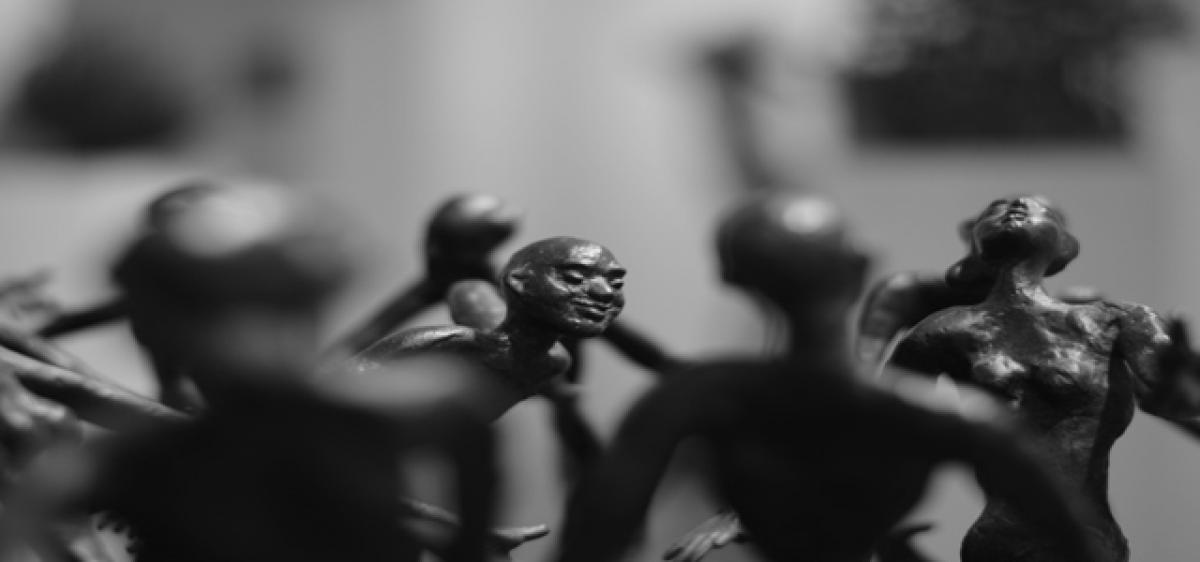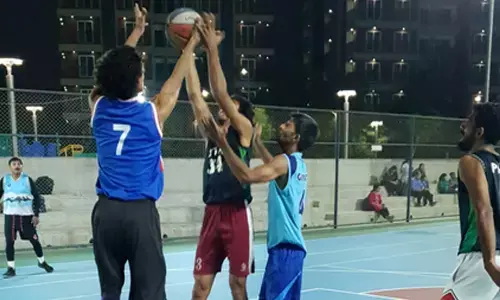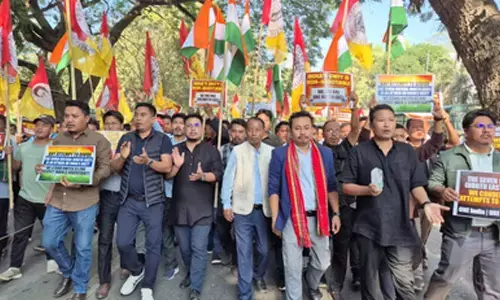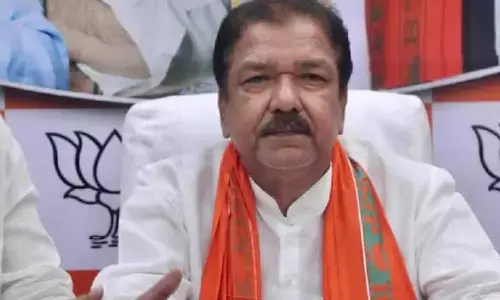Getting emotional appeal in Bronze

KS Radhakrishnan is a renowned sculptor whose alma mater is Santiniketan, where he was the last student of Ramkinkar Baij, the doyen of sculpture. Settled in New Delhi for more than three-and-a-half decades, Radhakrishnan has been working meticulously in bronze.
KS Radhakrishnan is a renowned sculptor whose alma mater is Santiniketan, where he was the last student of Ramkinkar Baij, the doyen of sculpture. Settled in New Delhi for more than three-and-a-half decades, Radhakrishnan has been working meticulously in bronze.
The sculptor may be using a traditional medium to work on but approaches it in a modern way. The end product – be it the smaller sculptures or the large-sized ones in public spaces are pleasurable to view. Due to tutelage and his close association with Ramkinkar Baij, Radhakrishnan curated a retrospective exhibition on Baij, which included not just a show (which was displayed in New Delhi and travelled to Bengaluru and Mumbai) but also many publications too. Radhakrishnan was in Hyderabad, after five years for his exhibition at Kalakriti Art Gallery.
The retrospective Radhakrishnan put together on Ramkinkar Baij was a monumental one “I was the last student of Ramkinkar Baij. I was lucky I was around when he was alive. It was my formative period in Santiniketan. Being with Ramkinkar was like exploring endless ways – you are seeing him at work, he was the master that you could really get inspired.
I became very close as a student to two teachers Sarbari Roy Chowdhury and Ramkinkar Baij – they were instrumental for me to become a sculptor too because I went to Santiniketan to do painting and then shifted to sculpture.
In the centenary year of Ramkinker Baij in 2006, the Union government decided to have a big exhibition. They thought of someone, who is a sculptor and knows his works closely and hence they chose me to curate it. I took it up even though I am not a curator. I worked three-four years on the job documenting the works, which were scattered.”
“It was a challenging job – a big journey - sourcing sculptures, identifying them and authenticating them and that process was very important for a sculptor’s work to be documented well first. Santiniketan and the National Gallery of Modern Art had good collections.
I added from a lot of private collections. We thought the exhibition should have the right publications. I am glad some of the artists went from Hyderabad to Bengaluru to see it. Though Ramkinkar belonged to Bengal, the retrospective was not taken to Kolkata as they could not show it in a non-government building for security reasons. I think it was a major show and a platform created for others to work,” Radhakrishnan adds.
Once he made the shift from painting to sculpture there was no looking back for Radhakrishnan. He chose bronze, a traditional metal to sculpt. “Sometimes because of bronze, I am able to make it stand with very minimum contact and the air-boundness and evoke lightness because of bronze.
No other material can give me the scope of things that I am trying to do – tiny figures are put together in hundreds in a composition.” On approaching the medium in a modern way Radhakrishnan says: “I always felt you don’t have to work on a modern medium to be modern.
You don’t have to be modern dressed to be a person belonging to the time.” Bronze is malleable as “in the casting, one has tremendous freedom of creating those forms.” As Radhakrishnan has been working in bronze for decades he has become comfortable with it. “Comfort level is an important level for you to be expressive. I never felt any restriction or limitations with bronze over the decades. I am not comfortable with fibreglass.”
Working with Ramkinkar and Sarbari Roy Chowdhury would be anyone’s dream and Santiniketan gave Radhakrishnan full scope for that and a lot of room for evolving. “It had a great tradition of sculptors, who lived and worked there.
Ramkinkar was, no doubt, the foremost father figure, who lived and worked there all his life. The space and the kind of learning process were such that there was interaction with nature. One reacted to the immediate environment and all that naturalism helped us to express things of our choice. That also helped in responding to the urban environment when I came to Delhi on a fellowship.”
On coming to Delhi Radhakrishnan saw the human drama, concerns and issues of the migrants coming and settling down in a colony, where he had his studio. Inspired by this, he created his human boxes, the tiny anonymous figures getting into all kinds of spaces and the crowd they are becoming and a cubical order that is getting dissolved ascending figures and descending wanting to reach out to a kind of stage.”
Hence, there is an element of life in these sculptures, a happy outlook and a positive feeling. The sculptor who manages to achieve that says, “I want to give some impression that you can see the figures with minimum contact and volume in space. If there is 100 kilos or 200 kilos of bronze it is definitely meant to be walking that lightness. Here when you see, you open up. You feel much lighter. It is meant to evoke that.”
Radhakrishnan’s muses Musui and Maiya continue to be there with him. “They have been a part of my artistic journey for the last 22 years. I find it easy or through them, I can reach my art to the public. They are the carriers of my message. They are an integral part of the making of me as a sculptor. They reach out to various kinds of quality of space,” he says.
In recent times Radhakrishnan did make a departure by sculpting a Buddha. It was a different kind of an approach – highly shined reflective pieces. Radhakrishnan has been doing sculptures in open spaces. He has done one in Goa, where the International Film Festival of India will be held.
“We have such a rich tradition of sculptures, temple monuments and we do not have the right conservation, restoration and if there is something broken then we hear ‘Oh we have enough’ – that is the kind of approach.
So it is very sad.” Radhakrishnan makes them with so much of effort and commitment. “I do public art with these two mediums – granite and bronze – thinking that they are two of the strongest traditional mediums and people may not be able to destroy it easily. I try to tell people it is done for you and you have to take the responsibility.
I want the public to take the responsibility and I hope that happens. In most cases, the bronze figures are kept atop of a stone and people can’t reach them as it is at a height.”How do you look at the sculptural scenario today as there are so many mediums being explored?
“I feel people have liberty to choose to work with different mediums to suit their temperament and also their expertise. It’s a most welcome scenario. Many people are working on various things. I think what is most important for the artist to see is it connected with you?
As long as there is some connection with the maker some connection will be established with the people who are seeing it from outside but if it is something that they are isolated from, then it becomes very isolated for the people and people also will not make any effort to connect to their art. So there should be an emotional element. Otherwise, it becomes an object in isolation.”
In one of the earlier interviews, Radhakrishnan had said, “If I had not been a sculptor I would have been a filmmaker.” “My father was into acting. He directed a few plays in Malayalam. I thought I would go to Film Institute and then to Santiniketan.
Even my father was keen on that. He saw my interest in art and wanted me to be in that space but then this turned out to be different. I always thought if ever I make any kind of shift in my life I would probably think of that space. The occasion never came so far to shift. I didn’t feel the need to do so also.
I got involved with sculpting. I have many filmmaker friends and I see films. Adoor Gopalakrishnan is a close friend of mine. The film is one medium, which can draw people from all streams into one space. I had noted down ideas. Some script was getting expanded it’s just that it is a different kind of a craft. It is a collective job, teamwork. For working with everybody you need a different kind of energy,” he winds up















